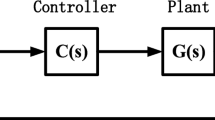Abstract
This paper presents a discrete time controller to attenuate influence of external disturbances. The proposed controller elevates tracking performance by suppressing a peak of a plant input sensitivity function. The controller is computed from an inverse model of a conventional plant input sensitivity function. For a stable and casual inverse model, we introduce all-pass filters and unit delays. In addition, high pass filters are utilized to avoid amplification of high frequency disturbance, which is a different approach from traditional design methods. Experimental verifications demonstrate the effectiveness of this design method and it is confirmed that the controller suppresses the sensitivity peak and enhances tracking performance obviously.


















Similar content being viewed by others
References
Åström KJ, Wittenmark B (1997) Computer-controlled systems theory and design, 3rd edn. Prentice-Hall, Massachusetts
Berenji HR, Saraf S, Chang P-W, Swanson SR (2001) Pitch control of the space shuttle training aircraft. IEEE Trans Control Syst Technol 9(3):542–551
Franklin GF, Powell JD, Workman ML (1990) Digital control of dynamic systems. Addison-Wesley, Massachusetts
Kang CI (2005) Discrete time disturbance observer design. SamSung internal seminar
Kempf CJ, Kobayashi S (1996) Discrete-time disturbance observer design for systems with time delay. AMC 1(18–21):332–337
Lam HY-F (1979) Analog and digital filters: design and realization. Prentice-Hall, New Jersey
Ohnishi K (1987) A new servo method in mechatronics. Trans Jpn Soc Electr Eng 107-D:83–86
Ohishi K, Toshimasa M, Inomata K, Yanagisawa H, Koide D, Tokumaru H (2006) Robust tracking servo system considering force disturbance for the optical disk recording system. IEEE Trans Ind Electronics 53(3):838–847
Park JY, Kim SM, Kim DH, Kim BK, Kwon SJ, Park J-O, Lee K- I (2005) Identification and control of a sensorized microgripper for micromanipulation. IEEE/ASME Trans Mechatron 10(5):601–606
Rigney BP, Pao LY, Lawrence DA (2006) Settle time performance comparisons of stable approximate model inversion techniques. Proceedings of the 2006 American control conference WeA18.5:600–605
Semba T (2003) A disturbance observer to suppress vibration effects of a HDD in a disk array system. Proceeding of the American control conference:1362–1367
Tomizuka M (1987) Zero phase error tracking algorithm for digital control. J Dyn Syst Meas Control 109:65–68
Vidyasagar M (1985) Control system synthesis: a factorization approach. The MIT Press, Massachusetts
White MT, Tomizuka M (2000) Improved track following in magnetic disk drives using a disturbance observer. IEEE/ASME Trans Mechatron 5(1):3–11
Yi L, Tomizuka M (1999) Two-degree-of-freedom control with robust feedback control for hard disk servo systems. IEEE/ASME Trans Mechatron 4(1):17–24
Author information
Authors and Affiliations
Corresponding author
Rights and permissions
About this article
Cite this article
Suh, S.M. Discrete-time controller design to attenuate effects of external disturbances. Microsyst Technol 15, 1645–1651 (2009). https://doi.org/10.1007/s00542-009-0865-7
Received:
Accepted:
Published:
Issue Date:
DOI: https://doi.org/10.1007/s00542-009-0865-7



